Specimen of the Week 199: Jar of…..
By Dean W Veall, on 3 August 2015
Hello Specimen of the Week readers, Dean Veall here. The specimen I have chosen can be found immediately in front of you as you enter the Museum doors in Cabinet 12. This is not just one specimen but an assemblage of many individual specimens each with its own story to tell. The specimen in this photo has probably been viewed by 90% of the 23,000 visitors we’ve had through the doors during normal opening hours this year. This week’s specimen of the week is……
**A Beach Scene or Seascape or jar of mixed marine phyla (I prefer Seascape)**
1). Say whaaaaaat?
Bet you thought I was going to say Jar of Moles. Well, my introduction was indeed all factually correct, so you can’t get me for that! The Museum’s most beautiful specimen (in my opinion) is indeed in the above photo, look carefully to the right side of the jar of moles in the space between them and the (also overlooked) jar of snakes and you can see the test tube containing the annelid worm.
This Seascape jar is truly a BEAUTIFUL specimen. Within this rather average sized jar an astonishing seven different phyla represented: Annelid worms (including what I think look likes a sea mouse), Arthopods (crustaceans and sea spiders), Chordates (a lone pipefish) Cniderians (jellyfish and sea anemones), Echinoderms (brittlestars, and sea cucumbers), Molluscs (mostly gastropods) and sponges or Porifera.
2). Conservation
We know very little about this Seascape, some individual specimens have numbers and are in the catalogue, but not all. From our records of conservation we do know this specimen was treated on 24th February 2005 by a Mel Bavington. Mel describes the work she carried out in her report: she replaced the jar (previously a glass jar with a metal top), added a formalin buffer to the fluid that was down to just 50% volume and placed what I can see are the more delicate specimens in individual glass tubes with plastic stoppers. A lovingly conserved specimen, in stark contrast to this other Seascape that I found deep in our spirit collection store.
With a historic collection of 68,000 specimens in our collection, conservation of our collection is a MAMMOTH task. Rest assured dear reader our conservation team are always hard at work on our specimens and to prove it here’s Emmy Kingham with our Aye-aye specimen
3). Endeis charybdaea
One specimen that is identified in the collection and could give us some clue to the origin of this Seascape is the sea spider Endeis charybdaea. Identified as Chilophoxis chalibolaeus on the specimen label I had trouble finding ANY information about this animal as it didn’t seem to exist. According to World Register of Marine Species it would appear that the genus Chilophoxis is no longer accepted and has been replaced by the genus Endeis. However, Endeis chalibolaeus was not to be found in any records either, there was a Endeis charybdaea which is a synonym of Chilophoxis charybdaea, so I’m going out there and saying that was was written down as Chilophoxis chalibolaeus should have been Chilophoxis charybdaea and is actually now Endeis charybdaea. Fair assumption?
What do we know of the sea spider Endeis charybdaea? Well, it can be found in waters from the Mediterranean to the North Atlantic and like other sea spiders is mostly carnivorous. There are 1,300 described species of sea spiders with some measuring just a few milimetres to up to a metre across (mostly in deep waters). Not actually arachnids, sea spiders are classifed along with horseshoe crabs in the Arthropod subphylum Chelicerata. Given the information we know about this species and the presence of other specimens with a similar distribution (like the sea mouse), I’m going out there and guessing that jar represents a Beach Scene of Sea Scape from somewhere in Western Europe.
4). The issue with Star Specimens
Many natural history museums have them: (Alfred the Gorilla in Bristol Museum or the Horniman walrus), those iconic specimens that have developed a star following all of their own. We at the Grant Museum have one ourselves, the afforementioned Jar of Moles. Specimens such as these are brilliant for attracting attention to collections and museums, especially when they turn into social media stars like our Jar of Moles has become. But as the Natural History Museum found recently with its proposed Dippy skeleton move, mess with the stars/divas at your peril! When I suggested placing this beaut of specimen in a more prominent position (as we normally do with Specimens of the Week), nearer the front of the cabinet, obstructing the Jar of Moles (only partially I may add), there was a cry of outrage from some within Team Grant. So, dear readers, instead of having its week in the limelight as Grant Museum of Zoology Specimen of the Week, you will have to make do with this image of my Seascape’s fleeting moment out of the dark shadow of star specimen The Jar of Moles!
Dean Veall is Learning and Access Officer at the Grant Museum of Zoology
One Response to “Specimen of the Week 199: Jar of…..”
- 1
 Close
Close



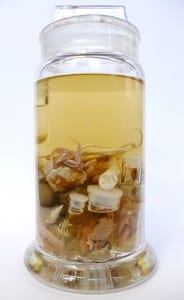
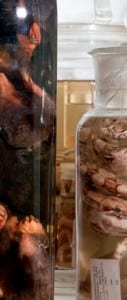
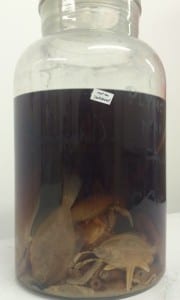

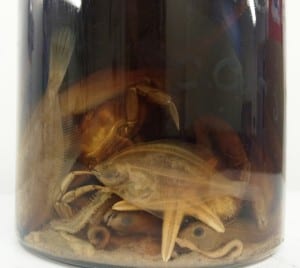
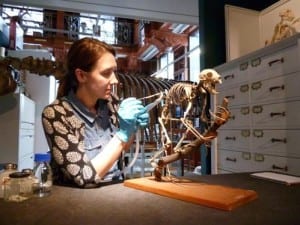
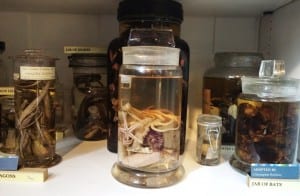
[…] presents you with specimens that are: dissected, bisected, exploded, stained, crammed with others in a jar or injected with alizarin. So as a case in point, here is the rinsed skeleton of a dolphin […]